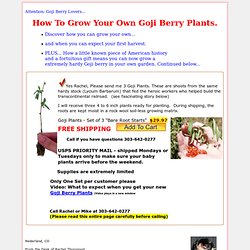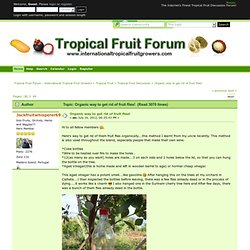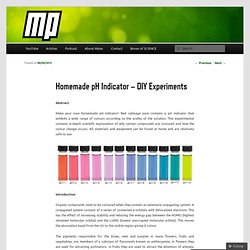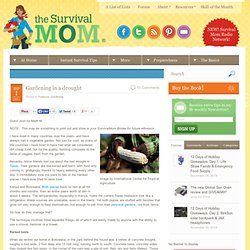

How To Grow Goji Berries. Attention: Goji Berry Lovers...

How To Grow Your Own Goji Berry Plants. Discover how you can grow your own... and when you can expect your first harvest.PLUS... How a little known piece of American history and a fortuitous gift means you can now grow a extremely hardy Goji berry in your own garden. Continued below... Organic way to get rid of fruit flies! Hi members.

MuShroomAgre. Com.post.ability. Mini Agros. Companion Planting Chart. Seeds at Risk in AgroBusiness. Cannabis Cultivarsity. Growing Technology. True Farmers. How to Make Hydroponic Solutions at Home. O Cultura. Agros Cultura. New Organica. Antarah Organica. Plant Cultivation. Diagnosis of Mineral Deficiencies in Plants by Visual Symptoms - Wallace, 1943. The processes concerned in the growth of plants are the subjects of study by plant physiologists and plant biochemists.

A comprehensive account of these processes is outside the scope of the present work, the special object of which is to deal with the outward and visible signs of imperfections in the plant's activities caused by faulty mineral nutrition. Nevertheless it is useful to have before us the general features of the main processes involved and to realize that the symptoms we shall be discussing later have a physiological basis, and are not direct and unchangeable signs of the specific deficiencies but result from the derangement of the complicated mechanism of the plant's vital activities. The main processes involved in plant development may be summarized as follows: Absorption: Intake of water and mineral elements by the root system. With all plants there are well defined seasonal growth cycles. Major elements: Nitrogen, phosphorus, calcium, magnesium, potassium, sulfur.
Alternative Soil Amendments. Balancing Soil Using Organic Minerals. Soil Fertility Fertile soil is a mixture of well-balanced minerals, high organic matter, humus, humic, fulvic and carbonic acids, good aeration and bountiful soil life.

The biology or life in the soil is at its healthiest when the nutrients are plentiful and balanced, and there is sufficient oxygen and water. The top few inches of soil is the most vital, holding about 70% of the life and 70% of the organic matter. Below 6 inches the roots are feeding on mostly soluble nutrients since the micro-organisms are not able to thrive without sufficient oxygen. It is possible to create biological activity deeper with deep double dug or mechanical disturbance like spading. Compost The best and cheapest organic fertilizer is compost. Taking a Soil Sample The aerobic zone is usually only 6-7” deep and should be all you need to sample for annual crops.
Reading the Soil Test There are many labs around the country that give soil results. Organic Matter (O.M.) Phosphorus Potassium Magnesium Calcium Sodium pH. Beneficial Indigenous Organisms (BIM) - Effective Microorganisms (EM) From Gil A.

Carandang gil_carandang@hotmail.com www.herbanafarms.com ------------------------------------------------------------------------------------------------------------ Lacto Bacilli One of the major workhorse beneficial indigenous microorganism used in natural farming is lacto bacilli. This particular beneficial microorganism is popularly used in composting that specifically arrest foul odors associated with anaerobic decomposition. Lactic acid bacteria thrive and feed on the ammonia released in the decomposition normally associated with foul odors. Spraying diluted solution of lactic acid bacteria serum to the plant and soil helps plant growth and makes them more healthy.
Lactic acid bacteria is also known to produce enzymes and natural antibiotics aiding effective digestion and has antibacterial properties, including control of salmonella and e. coli. Homemade pH Indicator – DIY Experiments. Abstract Make your own homemade pH indicator!

Red cabbage juice contains a pH indicator that exhibits a wide range of colours according to the acidity of the solution. This experimental contains in-depth scientific explanation of why certain compounds are coloured and how the colour change occurs. Gardening in a drought. Guest post by Mark M.

NOTE: This may be something to print out and store in your SurvivalMom Binder for future reference. image by International Center for Tropical Agriculture. Shmita. The sabbath year (shmita Hebrew: שמיטה, literally "release") also called the sabbatical year or sheviit (Hebrew: שביעית, literally "seventh") is the seventh year of the seven-year agricultural cycle mandated by the Torah for the Land of Israel,[1] and still observed in contemporary Judaism.

During shmita, the land is left to lie fallow and all agricultural activity, including plowing, planting, pruning and harvesting, is forbidden by halakha (Jewish law). Other cultivation techniques (such as watering, fertilizing, weeding, spraying, trimming and mowing) may be performed as a preventative measure only, not to improve the growth of trees or other plants. Vegetable Gardening 101: A Humble Tutorial. 5 Secrets to a ‘No-work’ Garden. It took over 20 years of gardening to realize that I didn’t have to work so hard to achieve a fruitful harvest.

As the limitless energy of my youth gradually gave way to the physical realities of mid-life, the slow accretion of experience eventually led to an awareness that less work can result in greater crop yields. Inspired in part by Masanobu Fukuoka’s book, One Straw Revolution, my family experimented with gardening methods which could increase yields with less effort. Fukuoka spent over three decades perfecting his so-called “do-nothing” technique: commonsense, sustainable practices that all but eliminate the use of pesticides, fertilizer, tillage, and perhaps most significantly, wasteful effort. No-till Gardening. Gardeners traditionally dig, or turn over the top layer of soil before planting to get rid of weeds, and make it easier to use fertilizers and to plant crops.

This also speeds up the decomposition of crop residue, weeds and other organic matter. Tilling the soil is often the most strenuous of a gardener’s tasks. A complex, symbiotic relationship exists between the soil surface and the underlying micro-organisms, however, which contributes to a natural, healthy soil structure. Square Foot Gardening 101. Update! Check out our new Square Foot Gardening Infographic for even more tips, diagrams, a plant list and much more. I recently stumbled upon a book (All New Square Foot Gardening: Grow More in Less Space! By Mel Bartholomew) with an interesting gardening method called square foot gardening, and decided we would give it a try. I’ve always thought the idea of having a vegetable garden would be a lot of fun. Walking out to your square foot garden and picking a fresh tomato for tonight’s dinner appeals to the self-sufficient nature of most frugal individuals.